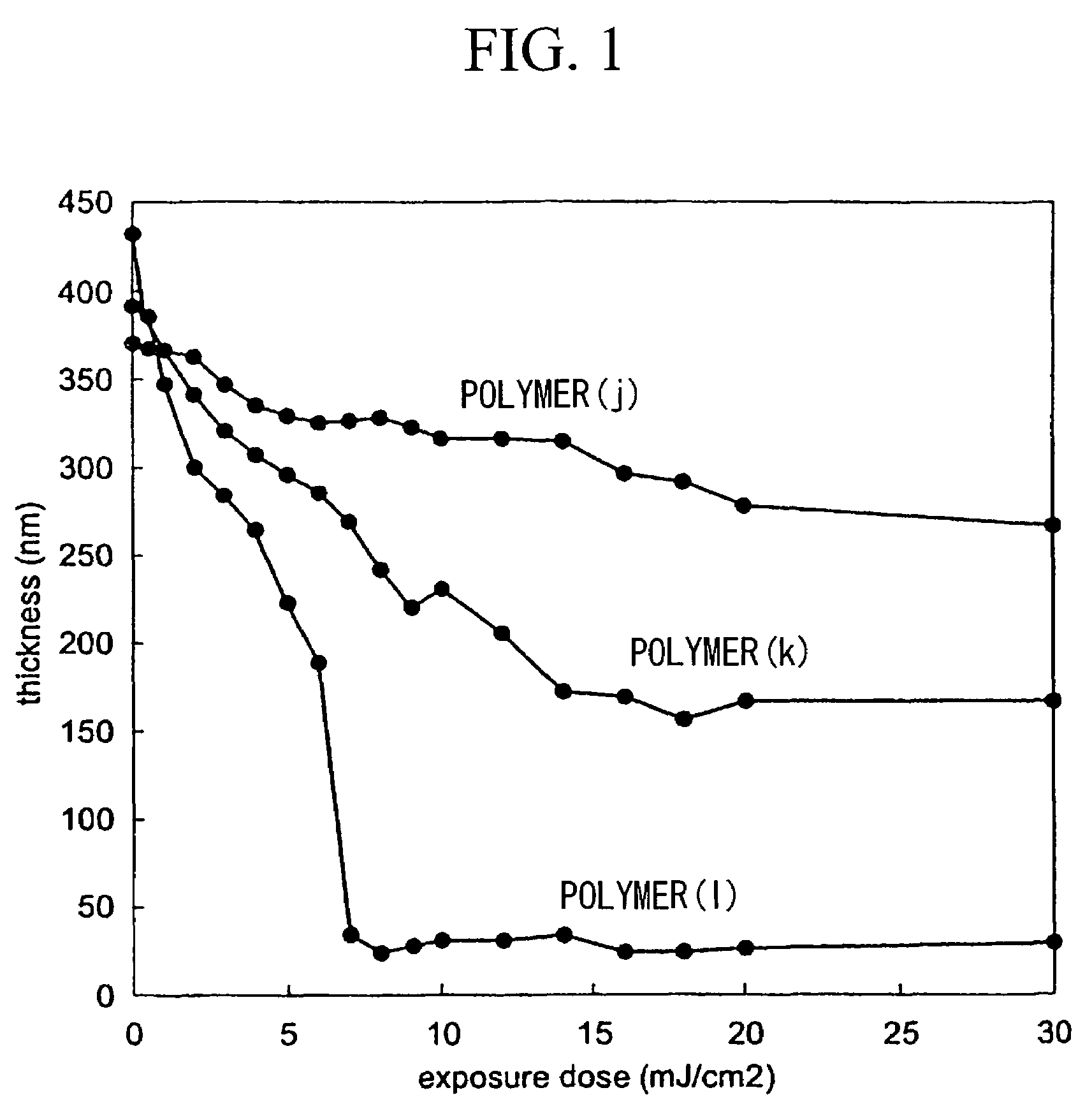Acid-degradable resin compositions containing ketene-aldehyde copolymer
a technology of ketenealdehyde and resin composition, which is applied in the field of resist composition, can solve the problems of some degree limitation in the performance of fine processes, and achieve the effect of improving resolution and extending do
- Summary
- Abstract
- Description
- Claims
- Application Information
AI Technical Summary
Benefits of technology
Problems solved by technology
Method used
Image
Examples
synthetic example 1
(1) Synthesis of Ethyl Phenyl Ketene (EPK)
[0118]A THF solution of 2-phenyl butyryl chloride (55 g, 0.3 mol) was added dropwise to a mixture of triethyl amine (91 g, 0.9 mol) in THF under nitrogen atmosphere. After one hour, precipitated triethyl amine hydrochloride was filtered. Filtrate was distilled under reduced pressure and EPK was obtained (60–70° C. / 4 mmHg). Amount obtained was 30 g (yield was 70%).
(2) Copolymerization of EPK with 4-methoxy benzaldehyde (MBA)
[0119]After 1.9 g (45 millimole) of lithium chloride was heated and dried under vacuum, 100 ml of THF was added under nitrogen atmosphere and the mixture was cooled to −40° C. After 4.4 g (32 millimole) of MBA and 4.4 g (30 millimole) of EPK were added, 0.93 ml (1.5 millimole) of the hexane solution of n-BuLi, and the reaction was continued for 30 minutes at −40° C. After the reaction was terminated by adding methanol, it was added to a large quantity of methanol to cause reprecipitation. The precipitate thus obtained was ...
synthetic example 2
(1) Synthesis of 4-(2′-ethoxyethoxy) benzaldehyde (EEBA)
[0120]After dissolving 24.4 g (0.2 mole) of 4-hydroxy benzaldehyde in 200 ml of ethyl acetate, 21.6 g (0.3 mole) of ethyl vinyl ether and 0.2 ml (2 millimole) of hydrochloric acid were added, and the mixture was stirred overnight at room temperature. Then, after adding Na2CO3 aqueous solution to neutralize, the mixture was separated and the upper layer was washed with water until pH thereof reached 7. After adding MgSO4 to dry, the mixture was filtered, concentrated and dried, and distilled under reduced pressure to obtain EEBA (100–105° C. / 0.4 mmHg). Amount obtained was 20 g (yield was 50%).
(2) Copolymerization of EPK with EEBA
[0121]The same procedure as described in Synthetic Example 1 (2) was repeated except that EEBA was used instead of MBA and white powdery polymer (b) was obtained. The polymer (b) was analyzed using GPC, and it was found that the polymer was a polymer having Mn of 4,800 and Mw / Mn of 1.25.
synthetic example 3
(1) 4-(t-butoxycarbonyloxy) benzaldehyde (BOCBA)
[0122]After dissolving 24.4 g (0.2 mole) of 4-hydroxy benzaldehyde in 200 ml of THF, 52.4 g (0.24 mole) of di-t-butyldicarbonate and 15 mg (0.2 millimole) of N,N-dimethylamino pyridine were added, and the mixture was stirred overnight at room temperature. Then, after adding Na2CO3 aqueous solution to neutralize, the mixture was separated and the upper layer was washed with water until pH thereof reached 7. After adding MgSO4 to dry, the mixture was filtered, concentrated, and recrystalized from methanol to obtain BOCBA. Amount obtained was 35 g (yield was 80%).
(2) Copolymerization of EPK with BOCBA
[0123]The same procedure as described in Synthetic Example 1 (2) was repeated except that BOCBA was used instead of MBA, and white powdery polymer (c) was obtained. The polymer (c) was analyzed using GPC, and it was found that the polymer was a polymer having Mn of 5,000 and Mw / Mn of 1.16.
PUM
| Property | Measurement | Unit |
|---|---|---|
| temperature | aaaaa | aaaaa |
| temperature | aaaaa | aaaaa |
| temperature | aaaaa | aaaaa |
Abstract
Description
Claims
Application Information
 Login to View More
Login to View More - R&D
- Intellectual Property
- Life Sciences
- Materials
- Tech Scout
- Unparalleled Data Quality
- Higher Quality Content
- 60% Fewer Hallucinations
Browse by: Latest US Patents, China's latest patents, Technical Efficacy Thesaurus, Application Domain, Technology Topic, Popular Technical Reports.
© 2025 PatSnap. All rights reserved.Legal|Privacy policy|Modern Slavery Act Transparency Statement|Sitemap|About US| Contact US: help@patsnap.com



